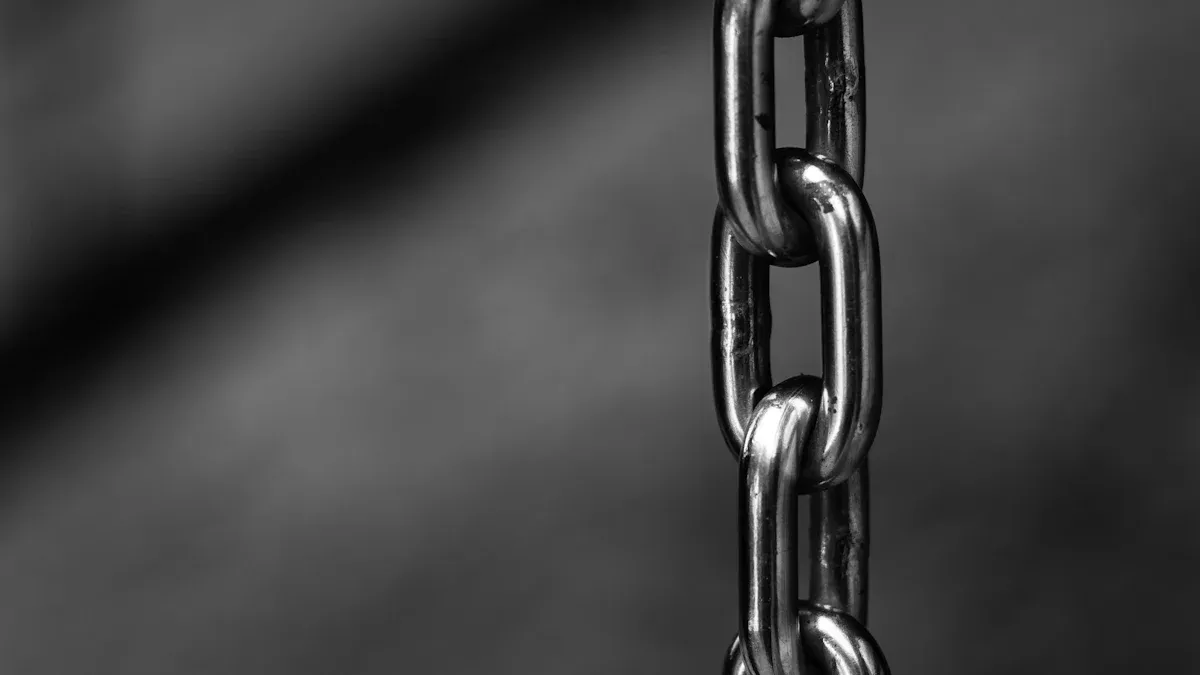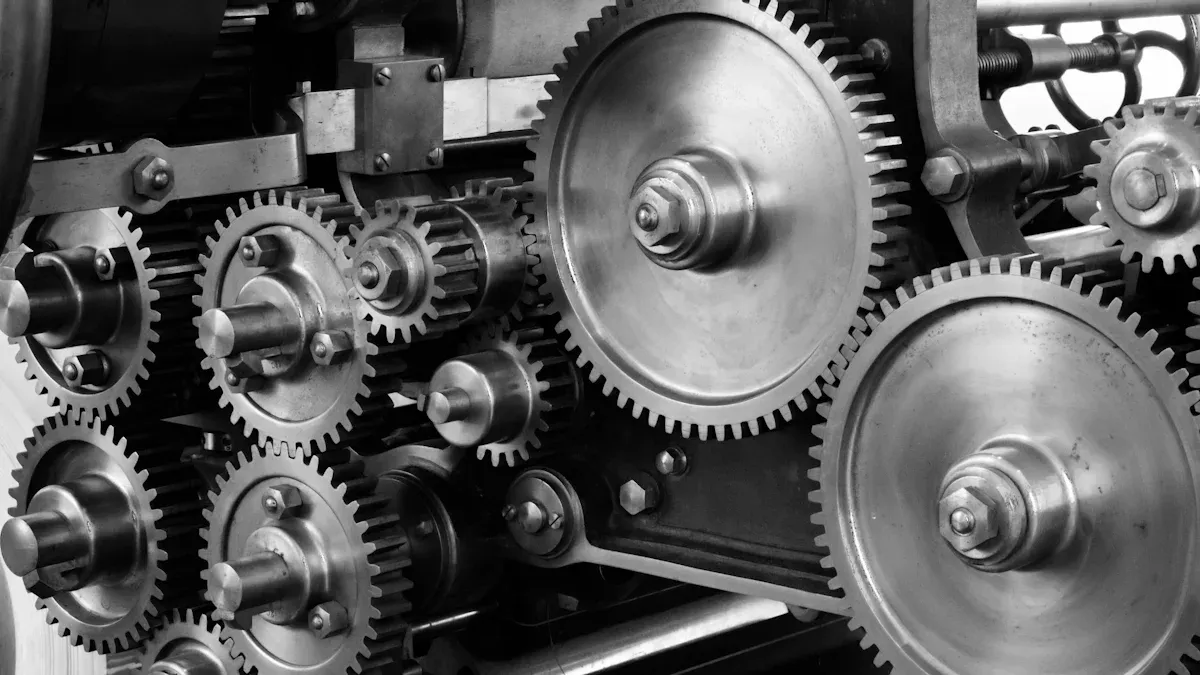
The former holder and chain system plays a crucial role in glove production. It moves glove molds through various stages like dipping, drying, and curing. This system ensures precision and efficiency, which are vital for mass production. With its ability to streamline processes, the former hold and chain system has become indispensable in modern glove manufacturing.
Key Takeaways
- The old holder and chain system helps make gloves faster. It moves molds automatically, saving time and reducing hard work.
- Checking and fixing the system often can make it last longer. This also stops delays and keeps the gloves made well.
- Using new tools and materials can make the system work better. It also lowers costs and helps your factory stay ahead.
Understanding Former Holder and Chain Systems

Components of the System
The former holder and chain system consists of several key components that work together to ensure smooth glove production. At its core, the system includes:
- Formers: These are molds shaped like hands. They serve as the base for creating gloves.
- Chains: These connect the formers and move them through the production line.
- Drive Mechanisms: These control the movement of the chains, ensuring precise timing.
- Control Panels: These allow operators to monitor and adjust the system as needed.
Each part plays a specific role. For example, the chains transport the formers through various stages, while the control panels help you maintain accuracy. Together, these components create a seamless process that boosts productivity.
Tip: Regular maintenance of each component can extend the lifespan of your system and prevent costly downtime.
Types of Systems
You’ll find different types of former holder and chain systems, each designed for specific needs. The two most common types include:
- Single-Line Systems: These systems are ideal for smaller production facilities. They use a single chain to move formers through the production stages. This setup is simple and cost-effective.
- Double-Line Systems: These systems are better suited for large-scale manufacturing. They use two parallel chains, allowing for higher production capacity and faster processing times.
Choosing the right system depends on your production goals. If you aim for efficiency and scalability, a double-line system might be the best choice.
Benefits in Manufacturing
The former holder and chain system offers several advantages that make it essential in glove production. Here are some of the key benefits:
- Increased Efficiency: The system automates the movement of formers, reducing manual labor and speeding up production.
- Consistency: By maintaining uniform timing and movement, the system ensures that every glove meets the same quality standards.
- Cost Savings: Automation minimizes errors and waste, which helps you save on materials and labor costs.
- Scalability: Whether you run a small facility or a large factory, the system can adapt to your production needs.
These benefits highlight why the former holder and chain system has become a cornerstone of modern glove manufacturing. It not only improves productivity but also ensures that your products meet high-quality standards.
Applications in Glove Production
Role in the Dipping Process
The dipping process is one of the most critical stages in glove production. During this step, the former holder and chain system transports the glove molds (formers) through tanks filled with liquid latex, nitrile, or other materials. This movement ensures that each mold gets evenly coated with the raw material, forming the base of the glove.
You can rely on this system to maintain precision. The speed and timing of the chain are carefully controlled, ensuring that the dipping process produces gloves with consistent thickness and texture. Without this system, achieving uniformity across large batches would be nearly impossible.
Note: Proper calibration of the dipping speed can help you reduce material waste and improve the overall quality of the gloves.
Contribution to Drying and Curing
After dipping, the gloves need to dry and cure to achieve their final form. The former holder and chain system plays a vital role here by moving the coated molds through drying ovens or curing chambers. These environments are designed to remove moisture and solidify the material, making the gloves durable and elastic.
The system ensures that each mold spends the exact amount of time required in the drying and curing stages. This consistency prevents defects like uneven curing or brittleness. You can also adjust the system to accommodate different glove materials, ensuring optimal results for every product type.
Ensuring Quality and Consistency
Quality and consistency are non-negotiable in glove manufacturing. The former holder and chain system helps you achieve both by automating key processes. It eliminates human error, ensuring that every glove meets the same high standards.
For example, the system maintains a steady pace throughout the production line. This uniformity ensures that each glove undergoes the same dipping, drying, and curing conditions. Additionally, the system’s automation reduces the risk of contamination, which is crucial for medical and industrial gloves.
Tip: Regular inspections of the system can help you identify and fix issues before they affect production quality.
Advancements in Former Holder and Chain Systems by 2025

Automation and Smart Technology
Automation has transformed the way you approach glove production. By 2025, former holder and chain systems integrate smart technology to optimize every step of the process. Sensors monitor the movement of formers, ensuring precise timing and reducing errors. Advanced software allows you to control the system remotely, making adjustments in real-time without halting production.
You can also benefit from predictive maintenance features. These systems analyze performance data to identify potential issues before they cause downtime. This proactive approach saves time and keeps your production line running smoothly. With automation, you achieve higher efficiency and maintain consistent quality across all batches.
Tip: Investing in smart technology upgrades can significantly enhance your system’s reliability and reduce operational costs.
Material Innovations
Material advancements have improved the durability and functionality of former holder and chain systems. Manufacturers now use lightweight yet robust materials like reinforced composites and stainless steel. These materials resist wear and tear, extending the lifespan of your equipment.
Innovative coatings also play a role. Anti-corrosion and heat-resistant coatings protect the system from harsh production environments. This ensures that your system performs optimally, even under demanding conditions. By choosing systems with advanced materials, you reduce maintenance needs and improve overall productivity.
Improved Efficiency and Cost-Effectiveness
Efficiency has reached new heights with the latest former holder and chain systems. Enhanced designs minimize energy consumption while maximizing output. You can produce more gloves in less time, reducing operational costs and boosting profitability.
Modern systems also streamline workflows. Features like automated chain tensioning and adjustable formers allow you to adapt quickly to different glove types. This flexibility helps you meet diverse customer demands without compromising quality. By 2025, these advancements make glove production faster, more reliable, and more cost-effective.
Note: Regularly updating your system ensures you stay competitive in the evolving glove manufacturing industry.
The former holder and chain system remains vital in glove production. It ensures precision, consistency, and efficiency. Recent advancements, like smart technology and durable materials, have improved productivity and reduced costs. These systems will continue evolving, offering you innovative solutions to meet growing manufacturing demands.
Key Takeaway: Investing in modern systems keeps your production competitive and future-ready.
FAQ
What is the lifespan of a former holder and chain system?
With proper maintenance, the system can last 10–15 years. Regular inspections and timely repairs help extend its lifespan.
Tip: Schedule routine maintenance to avoid unexpected breakdowns.
Can the system handle different glove materials?
Yes, modern systems are versatile. They can process latex, nitrile, and vinyl gloves by adjusting settings for dipping, drying, and curing.
How do you reduce downtime in production?
Use predictive maintenance tools and monitor performance data. These steps help you identify issues early and prevent costly delays.
Note: Upgrading to smart systems can further minimize downtime.
Post time: Apr-22-2025




